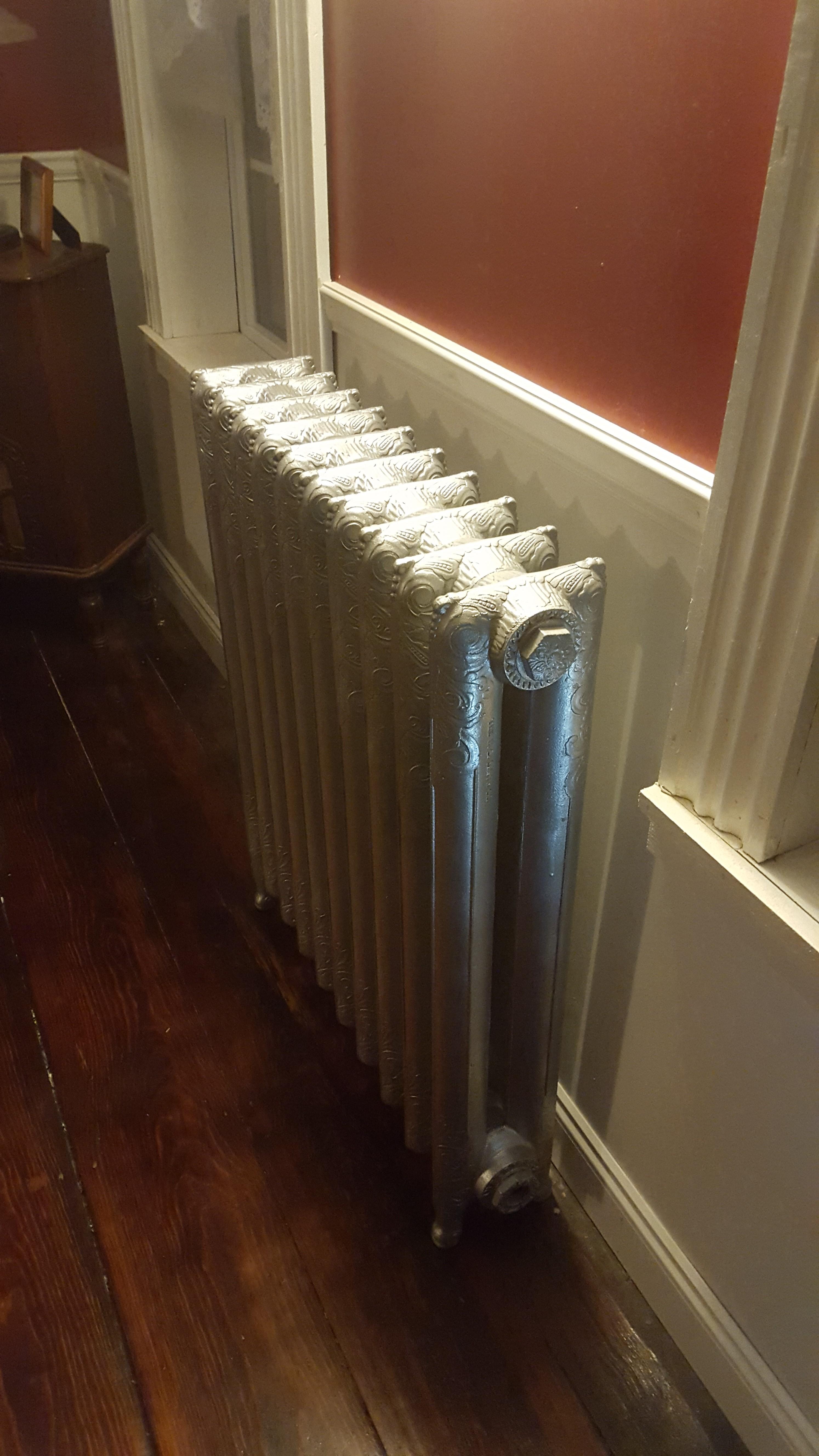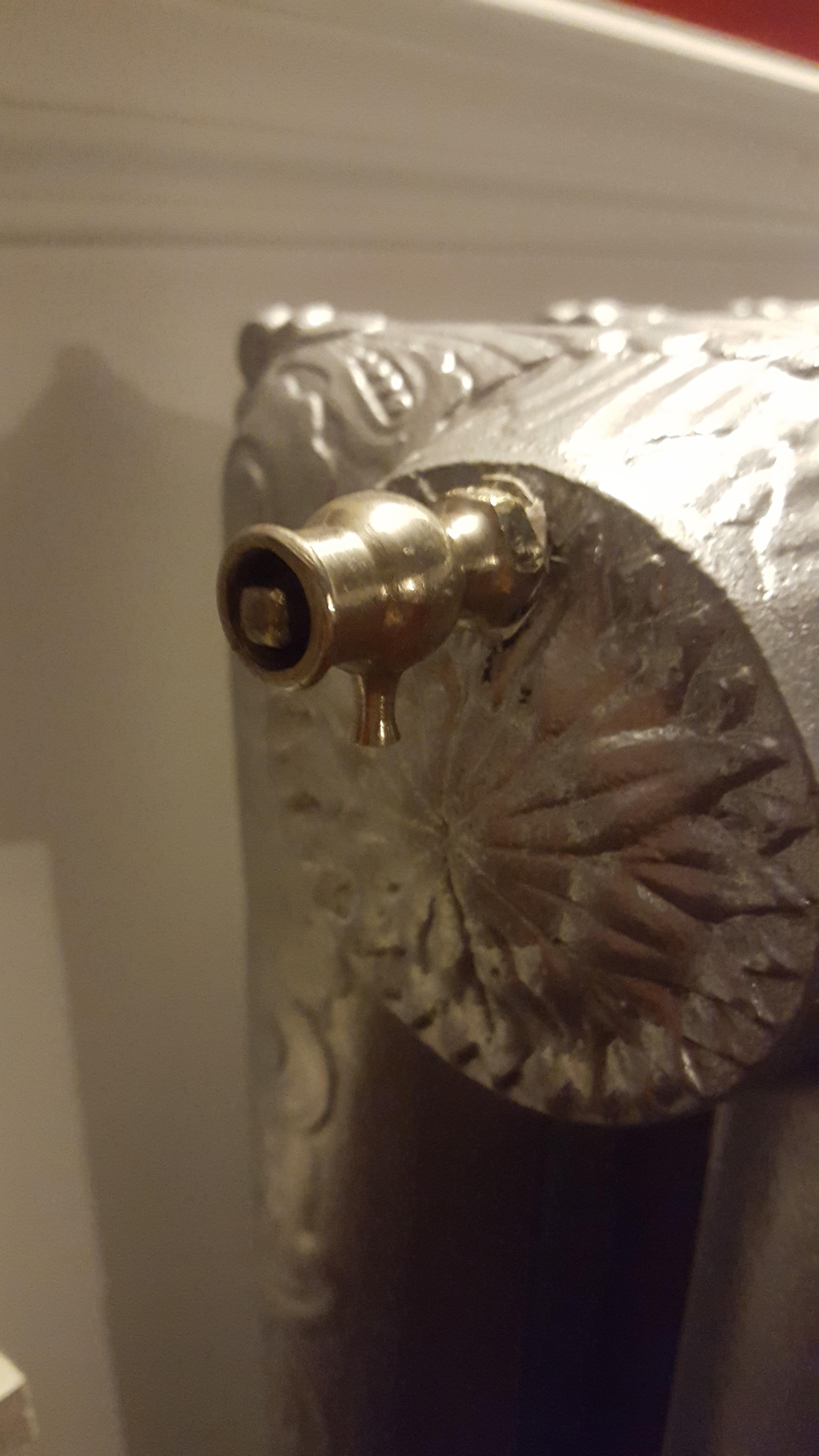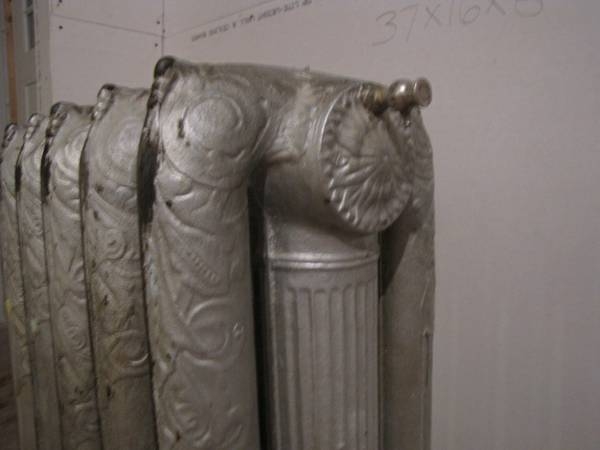home-made retrofit floor convectors?

First post here! I tend to talk a lot so here is the just of it:
Can I turn existing forced air vents in my floor into floor convectors using a simple water to air heat exchanger under each and let natural convection draw heated basement air into the room?
To get on with the full story, I am in the midst of converting my 1898 house from forced air to fhw and just fired my new pensotti dk2-4 for the first time last night. The house has been so far and always will be a unique and beautiful obsession and ongoing experiment of mine. We have other heat sources so there will be no emergency situation if this doesn't work at all.
This idea came to me awhile ago, because we decided to finish the original wide-pine floors in the main area/ living room of the house before removing the trusty 1982 Airco air furnace and its 8 supply vents and cold air returns. So here I am with a beautiful living room floor with several refinished somewhat ornate registers throughout. Rather than removing them and trying to patch in with pine or just using them as an indicator that the basement light was left on I'd like to put them back to work.
A heat loss I did for the room suggested 13-18,000 BTU depending on deltaT of outside air. I am in central Maine so we usually experience about a week of sub-zero temperatures in late January. So at 550btu/ft thats about 24-36' of 3/4" baseboard. I would probably go with 30'. Which is, if it were totally up to me, what the room would be fitted with.
Is it ever up to me though? The Mrs. is really against using the wall space. Growing up in radiant heated house she is a little spoiled. She really wants me to use the staple up radiant method but I'm sure we all know what the floor stringers look like in a pre-1900 post-and-beam house. It reminds me of a crossword puzzle. Plus the floor is 2.5" thick, littered with square nails, AND who here knows how a finished pine floor reacts to high temp radiant? Not me.
This would be its own zone with its own Grundfos 3-speed circ. 3/4" loop at full temperature (175). The piece I want to pick up are sold on EBay and other places and really designed for adding outdoor wood boiler heat to your existing hot air plenum. They can be bought in smaller sizes and at high cfm (chart shows 500-1000cfm ratings) are quite robust at like 20k BTU. Just don't know how well something with such dense fins would do at natural convection. I don't want to listen to that clank rattly blower anymore and with my allergies I really can't just stick one in the plenum and run the fan.
This is the same idea as the old indirect heat with the massive cast-iron radiators under the floor like Dan describes in one of his articles, with the major difference being the size of the unit and number of them. The basement has always been dry and not too musty so air coming up into the house is not a big deal. The basement stairway and a couple of the existing vents would be used to allow cold air back down there.
So, will it work do you think?! Let me know your thoughts.
-Joel
Comments
-
-
Paul we talked about a couple CI beasts for the house! I grew up with steam heat and am fond of them as well. I am also the only 22 year-old I know that has converted several of the steam rads for water. Nothing like spending hours with a sawzall and a chisel.
I could get my hands on a couple up here pretty easy too, you see a lot of them around in places. I'll try to talk her into it again.
I'm sure if my convector idea was the answer everyone would be doing it. Just me trying to reinvent the wheel.
-Joel0 -
About 21 years ago I did exactly this in a period home like yours. Used SlantFin toekick heaters with what they called "floor vectors". Every floor reg got one. Did a monoflo loop around the basement to feed them. First floor only. Looking back, I wonder how they've fared with dust and noise
 0
0 -
Bob, Glad to hear someone has done it! I would love to know how practical of a setup it was as well.
I've looked at the floor vector units but they are pricey and the two major differences are fan-fed and the return air comes from the room rather than basement. Maybe that is a good indicator that such a small convector needs a fan to boost output and my idea should be tossed.
They are 10,000 BTU a piece though! I could substitute 5 units without the fan at say 2500 BTU i'd be smiling. the only other setback is the less-than -ideal positioning of the ducts.
Say the BTU/ft output at natural convection is the same as baseboard. I'm sure its not but if it were, a 16x16" panel would essentially be a piece of 3/4" baseboard sliced 16" long 6.5 times side-by side. So equivalent of 8.6 ft of baseboard @ 550btu/ft = 4800BTU.
So feasible using my half-baked math I guess..Really just need to order a couple and try it.
-Joel0 -
I'm sorry, I got my products mixed up. It's been so many years. It's the Beacon Morris toe kick with the floor adapter. K4200 might fit the bill. On low speed they aren't too bad, high speed can get obnoxious. Check their rating tables and see if one or a couple combined on low speed output meets the rooms' heat loss.
It'd be tough to quantify how much heat you'd produce from simply putting a hydrocoil in ductwork to work passively. Nice thought though.
if I remember in that jobs case, it was the expense of getting radiators, or the headroom killer ductwork would have been.0 -
The Morris units seem like a 'good rig' and i'll keep them in mind. Thanks for all the input Bob! I looked around some today for CI rads and talked to Alicia about it again she finally arrived at the "its your house do what you want" which is never a good thing.
Tonight I'll work on building the mixing station for the radiant in that new slab. Give you guys some more time to chime in before I pull the trigger on something. Going thermostatic for now with plans of future modulating valve w/ outdoor reset. primary-secondary loop bypass setup. closely spaced tees. lots learned from this site so far!
Just so were clear I intend on removing ALL of the duct work from the house and the bottom of the 'hydrocoil' would be totally open to the space and simply suspended under the register with some possible flashing to seal the hot-side to the reg. There are (3) 16x16" registers and (3) 12x10".-Joel0 -
to convect air between levels would seem to require some way of returning cool air from the upper level to the lower level, correct? With baseboards and CI radiators the air is convecting within the room.Hydronics inspired homeowner with self-designed high efficiency low temperature baseboard system and professionally installed mod-con boiler with indirect DHW. My system design thread: http://forum.heatinghelp.com/discussion/154385
System Photo: https://us.v-cdn.net/5021738/uploads/FileUpload/79/451e1f19a1e5b345e0951fbe1ff6ca.jpg0 -
http://smithsenvironmental.com/wp-content/uploads/2015/07/Smiths-FL100-Brochure.pdf
http://smithsenvironmental.com/wp-content/uploads/Smiths-Heatpack-Coil-Brochure.pdfYou didn't get what you didn't pay for and it will never be what you thought it would .
Langans Plumbing & Heating LLC
732-751-1560
Serving most of New Jersey, Eastern Pa .
Consultation, Design & Installation anywhere
Rich McGrath 732-581-38330 -
-
Thanks for the help guys. I will still do something to this effect just as a test but I also did some convincing and the hunt is on for a couple ornate CI rads.
Also the newly heated 14x24' slab under the kitchen is doing a nice job of maintaining the house all by itself on these ~40F* nights we've been having. Buys us some time to get what we want in the living area where it is getting passive heat from the kitchen before it gets too cold.
-Joel0 -
Took your guy's advice and picked up some cool old CI rads for the room.
Did some research they are 1907 H.B. Smith 'Imperial' 2 column HW rads, one 6 section and one 10 sec. 24 & 40ft EDR according to some old literature. So 10,880 BTU just under design condition loads. May add another rad or some fin-tube to the room still considering options.
Leak checking, sandblasting, and a quick coat of rustoleum to match the tin ceiling. Now moving them around the room to choose the best placement for heat loss & aesthetics. I'll feed the zone off a manifold with 1/2" pex and some valves for flow balancing. In & out the bottom at a slow flow rate grundfos 15-58 on low like 2 gpm?
Also Picked up a couple plain 5 tube radss for some heat in the cellar/under the floor to be put on the same zone.





-Joel2 -
-
Yes he is! He is a very curious puppy and wanted to know about the new fixture. I made him sit for the photoBobC said:Your dog is waiting for the heat to come up.
Bob
-Joel0 -
They add so much to the aesthetics and look original to the house. Good jobTwo-pipe Trane vaporvacuum system; 1466 edr
Twinned, staged Slantfin TR50s piped into 4" header with Riello G400 burners; 240K lead, 200K lag Btus. Controlled by Taco Relay and Honeywell RTH6580WF0 -
-
@njtommy thanks! It needs another coat and I need to finish sandblasting the bigger one. then I'll plumb them up and post how it goes.
Hoping the added mass isn't a big risk to my boiler without a primary bypass. I think in+out the bottom will let the return water temp rise quickly as it shoots across.
Still going to experiment with my convector idea in the den and hallway I think, just for closure of this thread and in my mind
-Joel0 -
Used a different primer on the 10 section one and it came out much shiner.
I also found these neat vents that I cleaned up and added. Now if I just had the funny little 4-sided key that was used to open them!

-Joel0 -
I was going to ask where you found the dog radiator.sonofaplumber said:
Yes he is! He is a very curious puppy and wanted to know about the new fixture. I made him sit for the photo 0
0 -
-
RE those air bleeds: I actually found a box of ten of those at a small local supply house, brand new. I no longer have the box, but that's what I used on all the radiators in my house. Identical to the one you have pictured there.
The key for them is the same as any other radiator bleed key. That same supply house sells them for a quarter apiece, so I bought 8 (I tend to lose one each heating season!). I know our local Menards store sells keys and bleeders paired together as well.
Very nice looking radiators.Ford Master Technician, "Tinkerer of Terror"
Police & Fire Equipment Lead Mechanic, NW WI
Lover of Old Homes & Gravity Hot Water Systems1 -
@FranklinD I figured a small 12 point socket might do the trick, but I'll try to hunt down a couple keys!
-Joel0 -
believe it or not homedepot use to have the keys. Try it in the heating isle should be near the air blenders and other little odds and ends for steam/ hydronics0
-
-
-
@sonofaplumber Your dog looks right at home in that picture. I used to have A GE that was about the same vintage.
BobSmith G8-3 with EZ Gas @ 90,000 BTU, Single pipe steam
Vaporstat with a 12oz cut-out and 4oz cut-in
3PSI gauge0 -
-
There are some health issues with bringing the basement heat into the living area (radon in Maine is one of them). It's illegal in Mass.
There are also safety issues. You would be building the perfect convective flue for a fire to spread.
The fan units would drive you crazy.
The radiators are beautiful!0 -
Dennis, Thanks for the insight! Being young and naive so far I have found that if it seems like a new idea, someone has already thought of it and there are reasons it is not commonly done.Dennis1679 said:There are some health issues with bringing the basement heat into the living area (radon in Maine is one of them). It's illegal in Mass.
There are also safety issues. You would be building the perfect convective flue for a fire to spread.
The fan units would drive you crazy.
The radiators are beautiful!
I threw the idea out a long time ago in this thread. I just never bothered to change the subject title and have no shame in trying to think outside the box.
And thank you we absolutely love them. They are supplied with 1/2" pex from a manifold at a very low flow and work perfect. About 15 degrees away from design temp for the space I saw a ~4 hour heat call. With 30+ min burner cycles. I put wye strainers on each return to collect any debris.
Another one I haven't shown yet in the basement also does great. Looking forward to placing wet gloves and boots near to dry.
Still need to connect some radiation to the other end of the house on this zone (bath & unfinished den). So on the hunt for some more ancient beauties.
-Joel0 -
The dogs not bad either.0
-
So does this mean I shouldn't be opening the basement door to capture some of the residual heat?Dennis1679 said:There are some health issues with bringing the basement heat into the living area (radon in Maine is one of them). It's illegal in Mass.
There are also safety issues. You would be building the perfect convective flue for a fire to spread.
The fan units would drive you crazy.
The radiators are beautiful!
Two-pipe Trane vaporvacuum system; 1466 edr
Twinned, staged Slantfin TR50s piped into 4" header with Riello G400 burners; 240K lead, 200K lag Btus. Controlled by Taco Relay and Honeywell RTH6580WF0 -
That's up to you but that residual heat prevents any heat loss through you first floor floors so it's not wasted. Insulating the piping is your best route for that.0
-
I would think that is on a slightly different scale than forcing the basement air upstairs with convection.
Heck all old homes with wood floors or an interior cellar door have some air exchange, I remember the house I grew up in you could feel the draft between the cracks in the floor!
I heat my basement as you can see in my last post, I need it somewhat conditioned as I use it for firewood that is stored down there (yes I know, another air quality/safety concern) and other storage.
I'm starting to see square nails rise up from above where that basement rad is though, tore a sock the other night!
-Joel0 -
We're a couple months into the heating season and the old iron brothers in the living room are considered family. We've gotten so many compliments on them.
So, we are going to pick up a third (and somehow) perfect matching one tonight.


-Joel0
Categories
- All Categories
- 87.3K THE MAIN WALL
- 3.2K A-C, Heat Pumps & Refrigeration
- 61 Biomass
- 429 Carbon Monoxide Awareness
- 120 Chimneys & Flues
- 2.1K Domestic Hot Water
- 5.8K Gas Heating
- 115 Geothermal
- 166 Indoor-Air Quality
- 3.7K Oil Heating
- 77 Pipe Deterioration
- 1K Plumbing
- 6.5K Radiant Heating
- 395 Solar
- 15.7K Strictly Steam
- 3.4K Thermostats and Controls
- 56 Water Quality
- 51 Industry Classes
- 50 Job Opportunities
- 18 Recall Announcements








